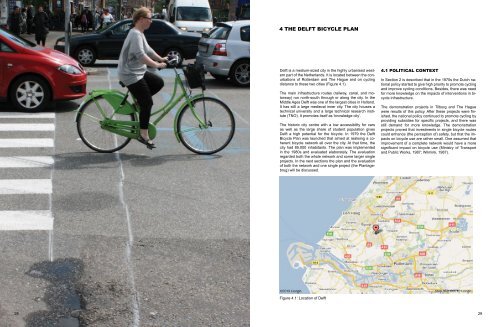Aalborg Universitet Bike Infrastructures Report Silva, Victor ... - VBN
Aalborg Universitet Bike Infrastructures Report Silva, Victor ... - VBN
Aalborg Universitet Bike Infrastructures Report Silva, Victor ... - VBN
You also want an ePaper? Increase the reach of your titles
YUMPU automatically turns print PDFs into web optimized ePapers that Google loves.
4 The Delft Bicycle Plan<br />
Delft is a medium-sized city in the highly urbanised western<br />
part of the Netherlands. It is located between the conurbations<br />
of Rotterdam and The Hague and on cycling<br />
distance to these two cities (Figure 4.1).<br />
The main infrastructure routes (railway, canal, and motorway)<br />
run north-south through or along the city. In the<br />
Middle Ages Delft was one of the largest cities in Holland.<br />
It has still a large medieval inner city. The city houses a<br />
technical university and a large technical research institute<br />
(TNO). It promotes itself as ‘knowledge city’.<br />
The historic city centre with a low accessibility for cars<br />
as well as the large share of student population gives<br />
Delft a high potential for the bicycle. In 1979 the Delft<br />
Bicycle Plan was launched that aimed at realising a coherent<br />
bicycle network all over the city. At that time, the<br />
city had 85,000 inhabitants. The plan was implemented<br />
in the 1980s and evaluated elaborately. The evaluation<br />
regarded both the whole network and some larger single<br />
projects. In the next sections the plan and the evaluation<br />
of both the network and one single project (the Plantagebrug)<br />
will be discussed.<br />
4.1 Political context<br />
In Section 2 is described that in the 1970s the Dutch national<br />
policy started to give high priority to promote cycling<br />
and improve cycling conditions. Besides, there was need<br />
for more knowledge on the impacts of interventions in bicycle<br />
infrastructure.<br />
The demonstration projects in Tilburg and The Hague<br />
were results of this policy. After these projects were finished,<br />
the national policy continued to promote cycling by<br />
providing subsidies for specific projects, and there was<br />
still demand for more knowledge. The demonstration<br />
projects proved that investments in single bicycle routes<br />
could enhance (the perception of) safety, but that the impacts<br />
on bicycle use are rather small. One assumed that<br />
improvement of a complete network would have a more<br />
significant impact on bicycle use (Ministry of Transport<br />
and Public Works, 1987; Wilmink, 1987).<br />
Figure 4.1: Location of Delft<br />
28 29
















